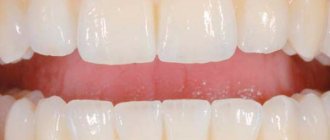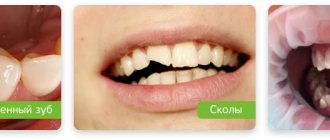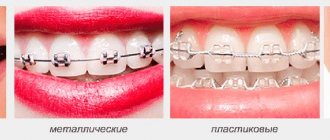Dental filling is one of the most popular services in modern dentistry. Naturally, the need to put a filling on a tooth arises for a reason: filling is carried out to restore dental units destroyed by caries, in the treatment of pulpitis and periodontitis. Putting a filling on a damaged tooth is necessary not only to close an unsightly and noticeable carious cavity. Fillings placed correctly and with high quality completely restore the aesthetics and function of the tooth.
When treating teeth, dentists can use a variety of types of fillings, but one of the most modern options is light fillings on the tooth. In the article we will tell you in detail about when you need to put a light filling on a tooth, what are the advantages and features of this type of filling material, how light fillings for chewing and front teeth differ, and also consider the prices for the service in Moscow.
Calculate the cost of treatment by taking a short test in 20 seconds!
Do not delay your treatment, because in this matter time plays against us.
What is a light filling and when does it become necessary to place it on a tooth?
What is a light filling and why do dentists recommend placing it on a tooth when treating caries? Light (photopolymer, light-curing) filling is what ordinary people far from medicine call a filling material that hardens only under the influence of ultraviolet radiation. The hardening process of light fillings occurs quickly - in just 40-60 seconds and to start it, the dentist will use a special UV lamp.
THIS IS INTERESTING: The speed of hardening of light fillings is one of their advantages. They harden under the influence of ultraviolet light in less than a minute and acquire high strength. Chemical filling composites take about 2 hours to harden.
Light fillings can be placed on teeth both for the restoration of chewing units and for high-quality restoration of teeth included in the smile zone. This type of filling material is highly durable, aesthetically pleasing, and has a wide range of shades, which allows you to select and place a light filling exactly to match the natural enamel of the patient’s teeth.
Indications for the use of light fillings are as follows:
— Treatment of caries, pulpitis, periodontitis of teeth.
During the treatment process, the dentist will drill out the tooth and remove all tissue destroyed by caries. As a result, a cavity is formed that needs to be closed both to prevent bacteria from entering the internal tissues of the tooth and to return the tooth to all its functions and attractive appearance; — You can also put a light filling on a tooth if the enamel is chipped, if part of the tooth breaks off due to a minor injury;
— In some cases, aesthetic restoration of teeth is carried out using light fillings. For example, if the tooth enamel has become very dark and cannot be whitened using professional whitening techniques.
But you should know that the decision to put a light filling on a tooth will not always be the right one - if your tooth is destroyed by more than 50%, it is better to restore it with an inlay or a crown. Light fillings have high strength, but with such tooth destruction they may not withstand constant and heavy load.
In what cases is it used?
Indications:
- carious and non-carious destruction;
- pathological changes in the size and color of crowns;
- injuries requiring restoration of chips, correction of damaged teeth (only if the coronal part is preserved at least 50%);
- pathological mobility I-III degrees (have a holding effect);
- small enamel defects (light-curing compounds allow you to create patches in small areas where other compounds will not adhere).
Light fillings for teeth: features and main characteristics
As we already wrote above, light fillings can be placed on both the front and chewing teeth. Photopolymer filling materials are especially in demand for the restoration of teeth included in the smile zone, because they are distinguished by high aesthetics.
Light filling materials are manufactured using nanotechnology and contain special microfillers that provide light fillings with not only high strength, but also the ability to accurately imitate the natural color of the tooth crown.
In terms of strength, light fillings are slightly inferior to chemical analogues, but at the same time they have better shock absorption and do not shrink. To increase the strength of attachment of the light filling to the dental tissues, before placing it, the dentist treats the cavity for the filling with a special adhesive composition.
Light filling for front teeth
If a light filling needs to be placed on the front teeth, which fall into the smile zone and are clearly visible to others, then a material with micro-filled components is used for restoration. Such a light filling will look as natural as possible, since it can be made with the same shade as the natural tooth enamel and polished to give the finished restoration a beautiful shine.
Light fillings for restoration of chewing teeth
When restoring chewing teeth, it is important to place a light filling on them with maximum strength, capable of withstanding constant and heavy load on the teeth when chewing food. For light fillings on chewing teeth, photopolymer composites with macrofilled components are used.
Distinctive features of the coating
When talking about this dental material, it is necessary to emphasize that it:
- It hardens only when treated with a special medical lamp , while ordinary fillings become hard as a result of a chemical reaction that occurs between their components and oxygen from the air. The bonds formed during the processing of the liquid photopolymer composition are much stronger. This means that the light “tab” will exactly repeat the shape of the carious “hollow”. There will be no gaps or microcracks between it and the walls of the tooth in which microorganisms could multiply. All this together significantly extends the service life of the material.
- May be of different shades. Therefore, the dentist has the opportunity to make a destroyed fang, molar or incisor beautiful, almost indistinguishable from its neighbors. The ability to match colors is very important when working with front units.
Advantages and disadvantages of light fillings on teeth
Compared to other types of fillings, light fillings have a number of advantages:
- The high plasticity of the material gives the dentist the opportunity to form a high-quality filling and, therefore, to thoroughly fill the cavity and all surface defects of the tooth being restored. The same quality of light fillings makes it possible to apply the material in layers and thereby ensure maximum strength of its adhesion to the natural tissues of the tooth;
- Hypoallergenic. All components included in the light fillings are not capable of causing allergic reactions in people;
- Light fillings make it possible to accurately reproduce the color of natural tooth enamel. To obtain the desired shade of the filling that is planned to be placed on the tooth, the dentist can mix several shades of material;
- Even when the material has completely hardened, the light fillings can still be properly sanded and polished. This has a positive effect on the level of aesthetics of the finished restoration.
But despite the large number of advantages, light fillings also have certain disadvantages. In particular, a light filling cannot be placed on a tooth if the tooth is significantly damaged. In addition, over time, such restorations can chip and change color. In this case, you will need to replace the light seal.
What does dental photopolymer consist of?
Light-curing filling composition includes:
- Heliocomposite. Used by dentists for direct dental restoration. New generation coating. Unable to freeze without a light source. It is absolutely harmless. It does not contain any impurities that could harm human health. Can be used without restrictions by pregnant and lactating women. Quite elastic. This means that during restoration activities, unwanted zoohardening will not occur. Under the influence of an ultraviolet lamp, heliocomposite decomposes into radicals. It is as a result of this process that the polymerization process of the filling is activated.
- Filler. It can be glass ceramics, silicon dioxide and other means. The structure, shade and area of application of the filling agent depend on the characteristics of the filler.
- Binding connections. Needed for reliable adhesion of all substances that form the light-hardening composition.
Putting a light filling on a tooth: how the treatment process will proceed
Treatment and restoration of a tooth with a light filling always begins with an examination of the patient’s oral cavity - this is necessary to make a diagnosis and select the correct treatment plan. If the examination is not enough for an accurate diagnosis, the patient is sent for an X-ray. Further tooth treatment and installation of a light filling will include the following steps:
1. Local anesthesia is given. The installation of the light filling itself is painless, but before this event the dentist will need to treat the tooth tissue and this can cause pain to the person.
2. The tooth being filled is protected from saliva by a rubber dam - a special latex lining that will prevent moisture from entering the cavity being treated. Even the smallest particles of moisture can negatively affect the strength and reliability of the restoration!
3. The dentist works with a diseased tooth, removing teeth damaged and destroyed by caries and forming a cavity for installing a filling. If caries has destroyed the tooth almost to the pulp, removal of the dental nerve may be required, as well as treatment and filling of the dental canals.
4. Having formed and treated the cavity in the tooth with antiseptics, the doctor will begin choosing the shade of the future light filling. A special scale is used for this; the dentist can also mix several shades of photopolymer material to obtain the color of the light filling that will perfectly match the tone of the natural tooth enamel.
5. The tooth cavity is dried and covered with a preparation based on orthophosphoric acid for 40 seconds. This drug improves the adhesion of the light filling to the natural tissues of the tooth.
6. After the specified exposure time, the drug with adhesive properties is washed off, and the cavity is thoroughly dried again.
7. Adhesive is applied to the tooth tissue, and then the doctor will begin laying out the filling material in layers. Each laid layer is exposed to ultraviolet radiation to ensure high-quality hardening and increase the strength of the light seal.
The procedure for installing a light filling ends with grinding and polishing of the restoration. On average, it takes a dentist 40-50 minutes to install one medium-sized filling.
Naturally, the treatment process and installation of a light filling for pulpitis and periodontitis will be longer. After all, before placing a light filling on a tooth, the doctor must make sure that the inflammatory process is completely eliminated.
We placed a light filling on a tooth: when can you start eating?
Light fillings are strong and reliable, and some dentists say that the patient can start eating almost immediately after their installation procedure. However, it will be healthier to refrain from eating for about 1-2 hours after you have a light filling placed on your tooth.
For three to four days after the light filling is installed, it is recommended to refrain from eating too hard foods and foods with coloring pigments. If you eat sweets, do not forget to rinse your mouth, because sweet and starchy foods provoke the active proliferation of carious bacteria.
conclusions
A photopolymer filling is the most perfect way to restore a damaged tooth to almost its original condition. Durability, lack of side effects and restrictions have made this technology popular all over the world. Reviews about such fillings are the most positive.
Such fillings cost several times more than chemical ones, if only because all the components are imported from abroad. But if you consider how long light seals last, then you can and should come to terms with the prices.
Choose a high-quality clinic, find out exactly how much and what you are paying for, and do not forget to take care of your teeth so that the filling serves you much longer than its intended period.
Light fillings on teeth: service life and tips to help avoid fillings falling out
If, after treating the tooth and installing a light filling, you strictly follow all the doctor’s recommendations, the restoration can serve you for 7-10 years without breaking or losing its visual appeal. In particular, you need to brush your teeth daily (at least twice a day), using not only a toothbrush and toothpaste, but also dental floss and mouthwash.
It is important to monitor your diet - it should contain a minimum of sweet foods and as much food rich in calcium as possible.
Smokers, people who abuse coffee and tea may need to change the filling earlier, as it may change its color from contact with the pigments of tobacco and drinks.
If you do not want the installed light seal to chip or fall out, do not do the following:
- Do not use ultrasonic brushes to clean your teeth, this can lead to loosening and loss of the filling;
- Remember that smoking and alcohol abuse can lead to a rapid loss of the aesthetic appearance of the light filling;
- Do not pick the line between the filling and the tooth with toothpicks.
If the filling suddenly chips, falls out, or you just want to restore its aesthetic appearance, do not try to restore it yourself, following advice from the Internet - contact the dentist.
Is it possible to experience discomfort after treatment?
After the procedure, slight discomfort is present for 14 days - this is normal.
. During this period, it is necessary to eliminate as much as possible the influence of factors that provoke unpleasant sensations - hot and cold foods, sour, spicy and sweet foods. You also need to avoid excessive stress and carry out hygiene procedures with caution.
But if pain occurs after this period has expired, this is a reason to consult a doctor. There are many reasons for this phenomenon, and only a specialist can accurately identify a specific one.
Prices for installing a light seal
The cost of installing a light filling will largely depend on the dental disease that needs to be treated and also on the volume of filling material required for high-quality tooth restoration. If you need to put a small light filling on a tooth, then the price of the service can vary between 2000 -3000 rubles. Large fillings for caries that have severely damaged teeth are more expensive - from 3,000 to 4,000 rubles.
Installing a filling for pulpitis and periodontitis will cost even more. Here the price of treatment will range from 5 to 10,000 rubles.
You can find out the exact cost of a light filling only after visiting the dentist’s office and undergoing an examination! We would like to draw your attention to the following point: the service life of light fillings depends on the quality of the materials and on the level of professionalism of the doctor who will carry out the treatment and restoration of the tooth. The risks of complications after installing a filling also depend on these factors. If the doctor makes mistakes when treating deep caries and pulpitis, the tooth under the filling may begin to hurt. Naturally, a poorly installed seal can chip or fall out at any time. Therefore, when planning to put light fillings on your teeth, always carefully choose dentistry for your treatment!
Calculate the cost of treatment by taking a short test in 20 seconds!
Do not delay your treatment, because in this matter time plays against us.
Pros and cons of photopolymer “tabs”
If we compare the light material with the usual one, the following advantages stand out:
- safe for health, does not contain toxic compounds;
- you can choose the desired shade and achieve impeccable aesthetics;
- after installation it is invisible to others;
- with proper care it lasts a very long time;
- is not an obstacle to further teeth whitening and grinding;
- very plastic, exactly repeats the shape of the recess;
- preserves the anatomical features of the tooth;
- allows you to eat and drink within half an hour after treatment;
- does not cause discomfort while wearing, absolutely imperceptible in the mouth.
Photopolymers also have disadvantages. So, they cannot be installed in hard-to-reach places. Their price is higher than a regular filling, which is also a disadvantage. For this reason, they are not used as a temporary “tab”.
Restoration of teeth using light fillings at VENSTOM dentistry in Moscow
In our dental clinic in Moscow - "VENSTOM" - dental restoration is carried out using high-quality photopolymer (light) filling materials from the world's leading manufacturers. Light seals made from such materials have a high level of aesthetics and maximum strength and reliability.
Dental treatment and installation of light fillings in our clinic are carried out in conditions that are comfortable for the patient and by experienced specialists who have the necessary knowledge base and experience to carry out high-quality dental restoration!
Do you still have questions about light fillings and dental treatment? Just dial the contact phone number of our clinic or write to the interactive chat on our website! We will honestly answer your questions and offer the widest range of dental services for the health of your teeth and the beauty of your smile!











